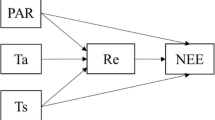Abstract
Resilience in ecosystems and resistance to regime shifts has been a major focus in ecological research. How migration and general network dynamics affect the resilience of populations or induce regime shift cascades is a particularly challenging open question in theoretical ecology. We focus on regime shifts in populations with variable-strength Allee effects to demonstrate the effect of migration on resilience in two-population systems with critical transitions. The result is a mathematical model that justifies the assumption that resilience can be averaged across connected populations and suggests several management strategies to either avoid or induce regime shift cascades.








Similar content being viewed by others
References
Amarasekare P (1998) Interactions between local dynamics and dispersal: insights from single species models. Jour of Theor Pop Biol 53(1):44–59
Beisner BE, Haydon DT, Cuddington K (2003) Alternative stable states in ecology. Front Ecol Environ 1(7):376–382
Bel G, Hagberg A, Meron E (2012) Gradual regime shifts in spatially extended ecosystems. Theor Ecol 5(4):591–604
Boettiger C, Ross N, Hastings A (2013) Early warning signals: the charted and uncharted territories. Theor Ecolol 6(3):255–264
Boulton CA, Good P, Lenton TM (2013) Early warning signals of simulated amazon rainforest dieback. Theor Ecol
Courchamp F, Berec L, Gascoigne J (2008) Allee effects in ecology and conservation. Oxford University Press, Oxford
Dai L, Korolev KS, Gore J (2013) Slower recovery in space before collapse of connected populations. Nature 496:355–359
Edelstein-Keshet L (2005) Mathematical models in biology. Soc Ind Appl Math. http://epubs.siam.org/doi/abs/10.1137/1.9780898719147
Gruntfest Y, Arditi R, Dombrovsky Y (1997) A fragmented population in a varying environment. J Theor Biol 185(4):539–547
Holling C (1973) Resilience and stability of ecological systems. Annu Rev Ecol Syst 4:1–23
Holt R (1996) Adaptive evolution in source-sink environments: direct and indirect effects of density-dependence on niche evolution. OIKOS 74(2):182–192
Liebhold A, Bascompte J (2003) The allee effect, stochastic dynamics, and the eradication of alien species. Ecol Lett 6(2):133–140
Scheffer M (2009) Critical transitions in nature and society. Princeton University Press, Princeton
Scheffer M et al. (2015) Generic indicators of ecological resilience inferring the chance of a critical transition. Annu Rev Ecol Syst 46:145–167
Taylor CM (2012) Allee effects. In: Encyclopedia of theoretical ecology
Author information
Authors and Affiliations
Corresponding author
Rights and permissions
About this article
Cite this article
Johnson, C.L., Hastings, A. Resilience in a two-population system: interactions between Allee effects and connectivity. Theor Ecol 11, 281–289 (2018). https://doi.org/10.1007/s12080-018-0365-4
Received:
Accepted:
Published:
Issue Date:
DOI: https://doi.org/10.1007/s12080-018-0365-4




